Applicability Study of a Global Numerical Weather Prediction Model MPAS to Storm Surges and Waves in the South Coast of Korea
Abstract
:1. Introduction
2. Methodology
2.1. Tide-Surge-Wave Model
2.2. Meteorological Forcing
3. Results and Discussion
4. Conclusions
Author Contributions
Funding
Institutional Review Board Statement
Informed Consent Statement
Data Availability Statement
Acknowledgments
Conflicts of Interest
References
- Knutson, T.R.; Chung, M.V.; Vecchi, G.; Sun, J.; Hsieh, T.L.; Smith, A.J.P. Science Brief Review: Climate change is probably increasing the intensity of tropical cyclones. In Critical Issues in Climate Change Science; Le Quéré, C., Liss, P., Forster, P., Eds.; Science Briefs: London, UK, 2021. [Google Scholar] [CrossRef]
- Na, H.; Jung, W.-S. Autumn typhoon affecting the Korean Peninsula—Past and present characteristics. J. Korean Soc. Atmos. Environ. 2020, 36, 482–491. (In Korean) [Google Scholar] [CrossRef]
- Yoon, S.B.; Jeong, W.M.; Joh, M.W.; Ryu, K.H. Analysis of reliability of weather fields for typhoon Maemi (0314). J. Korean Soc. Coast. Ocean Eng. 2020, 32, 351–362. (In Korean) [Google Scholar] [CrossRef]
- Ministry of Ocean and Fisheries. Report on the Estimation of Deep Water Design Waves of Korea; Ministry of Ocean and Fisheries: Seoul, Korea, 2019; pp. 117–149. (In Korean)
- Skamarock, W.C.; Klemp, J.B.; Duda, M.G.; Fowler, L.D.; Park, S.H.; Ringler, T.D. A multiscale nonhydrostatic atmospheric model using centroidal Voronoi tesselations and C-grid staggering. Mon. Weather Rev. 2012, 140, 3090–3105. [Google Scholar] [CrossRef] [Green Version]
- Yuk, J.-H.; Joh, M. Prediction of typhoon-induced storm surge, waves and coastal inundation in the Suyeong River Area, South Korea: A case study during typhoon Chaba. J. Coast. Res. 2019, SI91, 156–160. [Google Scholar] [CrossRef]
- Kang, J.-S.; Myung, H.; Yuk, J.-H. Examination of computational performance and potential applications of a global numerical weather prediction model MPAS using KISTI Supercomputer NURION. J. Mar. Sci. Eng. 2021, 9, 1147. [Google Scholar] [CrossRef]
- Luettich, R.A.; Westerink, J.J.; Scheffner, N.W. ADCIRC: An Advanced Three-Dimensional Circulation Model for Shelves, Coasts, and Estuaries—Report 1, Theory and Methodology of ADCIRC-2DD1 and ADCIRC-3DL; Coastal Engineering Research Center U.S.: Vicksburg, MS, USA, 1992. [Google Scholar]
- Westerink, J.J.; Luettich Jr, R.A.; Blain, C.A.; Scheffner, N.W. Adcirc: An Advanced Three-Dimensional Circulation Model for Shelves, Coasts, and Estuaries—Report 2 User’s Manual for Adcirc-2ddi; (No. WES/TR/DRP-92-6-2); Army Engineer Waterways Experiment Station: Vicksburg, MS, USA, 1994. [Google Scholar]
- Booij, N.R.R.C.; Ris, R.C.; Holthuijsen, L.H. A third-generation wave model for coastal regions: 1. Model description and validation. J. Geophys. Res. Ocean 1999, 104, 7649–7666. [Google Scholar] [CrossRef] [Green Version]
- Ris, R.C.; Holthuijsen, L.H.; Booij, N. A third-generation wave model for coastal regions: 2. Verification. J. Geophys. Res. Ocean 1999, 104, 7667–7681. [Google Scholar] [CrossRef]
- Dietrich, J.C.; Zijlema, M.; Westerink, J.J.; Holthuijsen, L.H.; Dawson, C.; Luettich, R.A., Jr.; Jensen, R.E.; Smith, J.M.; Stelling, G.S.; Stone, G.W. Modeling hurricane waves and storm surge using integrally-coupled, scalable computations. Coast. Eng. 2011, 58, 45–65. [Google Scholar] [CrossRef]
- Longuet-Higgins, M.S.; Stewart, R.W. Radiation stresses in water waves; a physical discussions, with applications. Deep Sea Res. Oceanogr. 1964, 11, 529–562. [Google Scholar] [CrossRef]
- Choi, B.H.; Min, B.I.; Kim, K.O.; Yuk, J.-H. Wave-tide-surge coupled simulation for typhoon Maemi. China Ocean Eng. 2013, 27, 141–158. [Google Scholar] [CrossRef]
- Choi, B.H.; Kim, K.O.; Yuk, J.-H.; Lee, H.S. Simulation of the 1953 storm surge in the North Sea. Ocean Dyn. 2018, 68, 1759–1777. [Google Scholar]
- Hope, M.E.; Westerink, J.J.; Kennedy, A.B.; Kerr, P.C.; Dietrich, J.C.; Dawson, C.; Bender, C.J.; Smith, J.M.; Jensen, R.E.; Zijlema, M.; et al. Hindcast and validation of Hurricane Ike (2008) waves, forerunner, and storm surge. J. Geogr. Res. Ocean 2013, 118, 4424–4460. [Google Scholar] [CrossRef] [Green Version]
- Kerr, P.C.; Donahue, A.S.; Westerink, J.J.; Luettich, R.A.; Zheng, L.Y.; Weisberg, R.H.; Huang, Y.; Wang, H.V.; Teng, Y.; Forrest, D.R.; et al. U.S. IOOS coastal and ocean modeling testbed: Inter-model evaluation of tides, waves, and hurricane surge in the Gulf of Mexico. J. Geophys. Res. Ocean 2013, 118, 5129–5172. [Google Scholar] [CrossRef] [Green Version]
- Lee, H.-Y.; Suh, S.-W. Application of EurOtop to improve simulations of coastal inundations due to wave overtopping. J. Coast. Res. 2016, SI75, 1377–1381. [Google Scholar] [CrossRef]
- Xie, D.; Zou, Q.; Cannon, J.W. Application of SWAN+ADCIRC to tide-surge and wave simulation in Gulf of Maine during Patriot’s Day storm. Water Sci. Eng. 2016, 9, 33–41. [Google Scholar] [CrossRef] [Green Version]
- Yuk, J.H.; Kim, K.O.; Choi, B.H. The simulation of a storm surge and wave due to typhoon Sarah using an integrally coupled tide-surge-wave model of the Yellow and East China Seas. Ocean Sci. J. 2015, 50, 683–699. [Google Scholar] [CrossRef]
- Egbert, G.; Ray, R. Semi-diurnal and diurnal tidal dissipation from TOPEXP/OSEIDON altimetry. Geophys. Res. Lett. 2003, 30, 1907. [Google Scholar] [CrossRef]
- Holland, G.J. An Analytic model of the wind and pressure profiles in hurricanes. Mon. Weather Rev. 1980, 108, 1212–1218. [Google Scholar] [CrossRef]
- Skamarock, W.C.; Park, S.-H.; Klemp, J.B.; Snyder, C. Atmospheric kinetic energy spectra from global high-resolution nonhydrostatic simulations. J. Atmos. Sci. 2014, 71, 4369–4381. [Google Scholar] [CrossRef]
- Park, S.-H.; Klemp, J.B.; Skamarock, W.C. A comparison of mesh refinement in the global MPAS-A and WRF models using an idealized normal-mode baroclinic wave simulation. Mon. Weather Rev. 2014, 142, 3614–3634. [Google Scholar] [CrossRef]
- National Centers for Environmental Prediction/National Weather Service/NOAA/U.S. NCEP GDAS/FNL 0.25 Degree Global Tropospheric Analyses and Forecast Grids; Department of Commerce: Boulder, CO, USA, 2015. [Google Scholar]
- Gao, J.; Luettich, R.; Fleming, J. Development and Initial Evaluation of a Generalized Asymmetric Tropical Cyclone Vortex Model in ADCIRC; ADCIRC users group meeting; US Army Corps of Engineers: Vicksburg, MS, USA, 2013.
- Musinguzi, A.; Akbar, M.K.; Fleming, J.G.; Hargrove, S.K. Understanding hurricane storm surge generation and propagation using a forecasting model, forecast advisories and best track in a wind model, and observed data—Case study Hurricane Rita. J. Mar. Sci. Eng. 2019, 7, 77. [Google Scholar] [CrossRef] [Green Version]
- Kang, J.-S.; Yuk, J.-H.; Joh, M. Performance of K-MPAS on typhoon track prediction with variable resolution grids focusing on Western Pacific Basin. J. Supercomput. Inf. 2017, 5, 5–11. [Google Scholar]
- Willmott, C.J. Some comments on the evaluation of model performance. Bull. Am. Meteorol. Soc. 1982, 63, 1309–1313. [Google Scholar] [CrossRef] [Green Version]
- Joh, M.; Yuk, J.-H.; Kang, J.S. Introduction of K-MPAS and verification of its typhoon track prediction. In Proceedings of the 15th Annual Meeting Asia Oceania Geosciences Society, Honolulu, HI, USA, 3–8 June 2018. [Google Scholar]
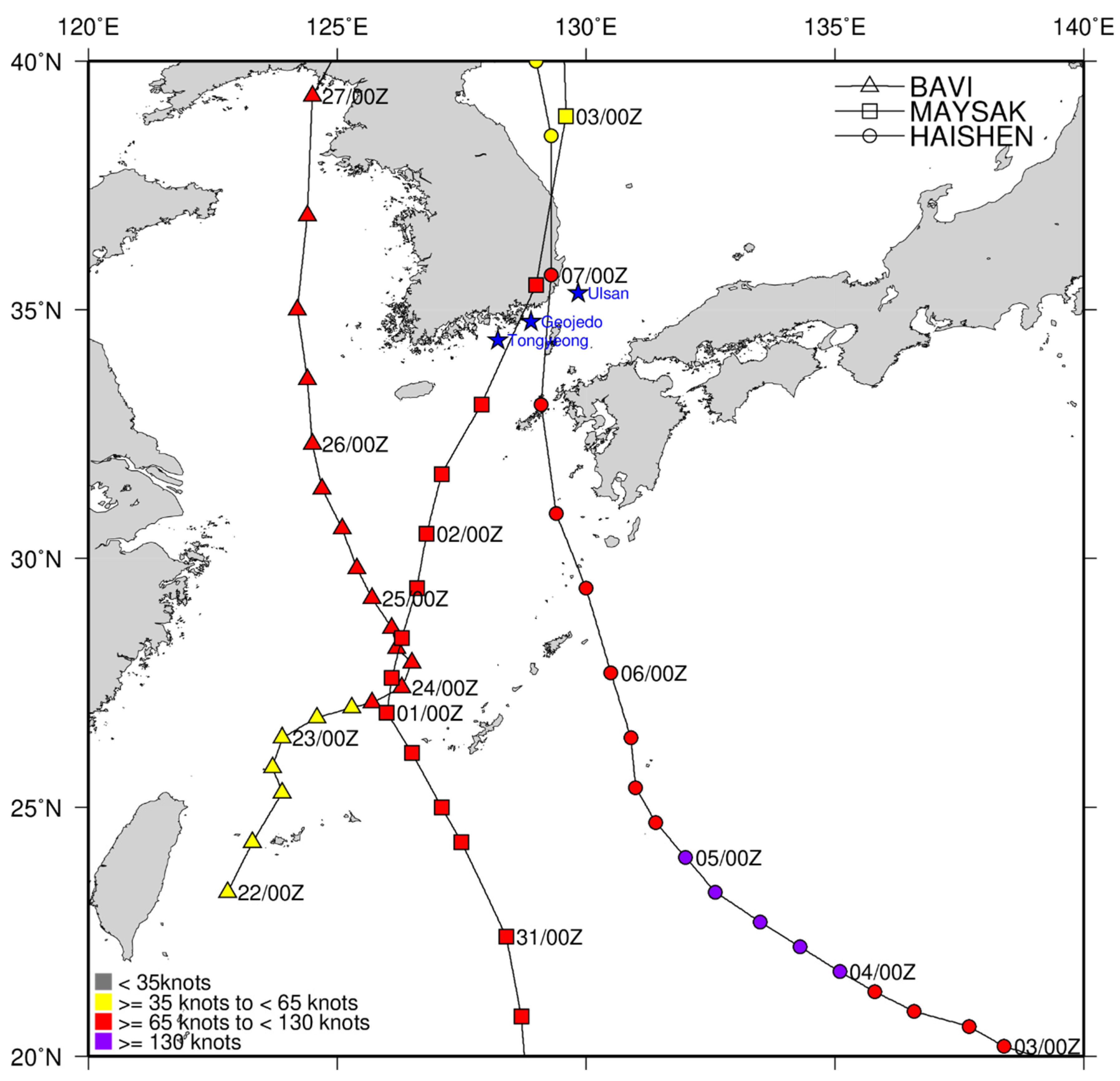

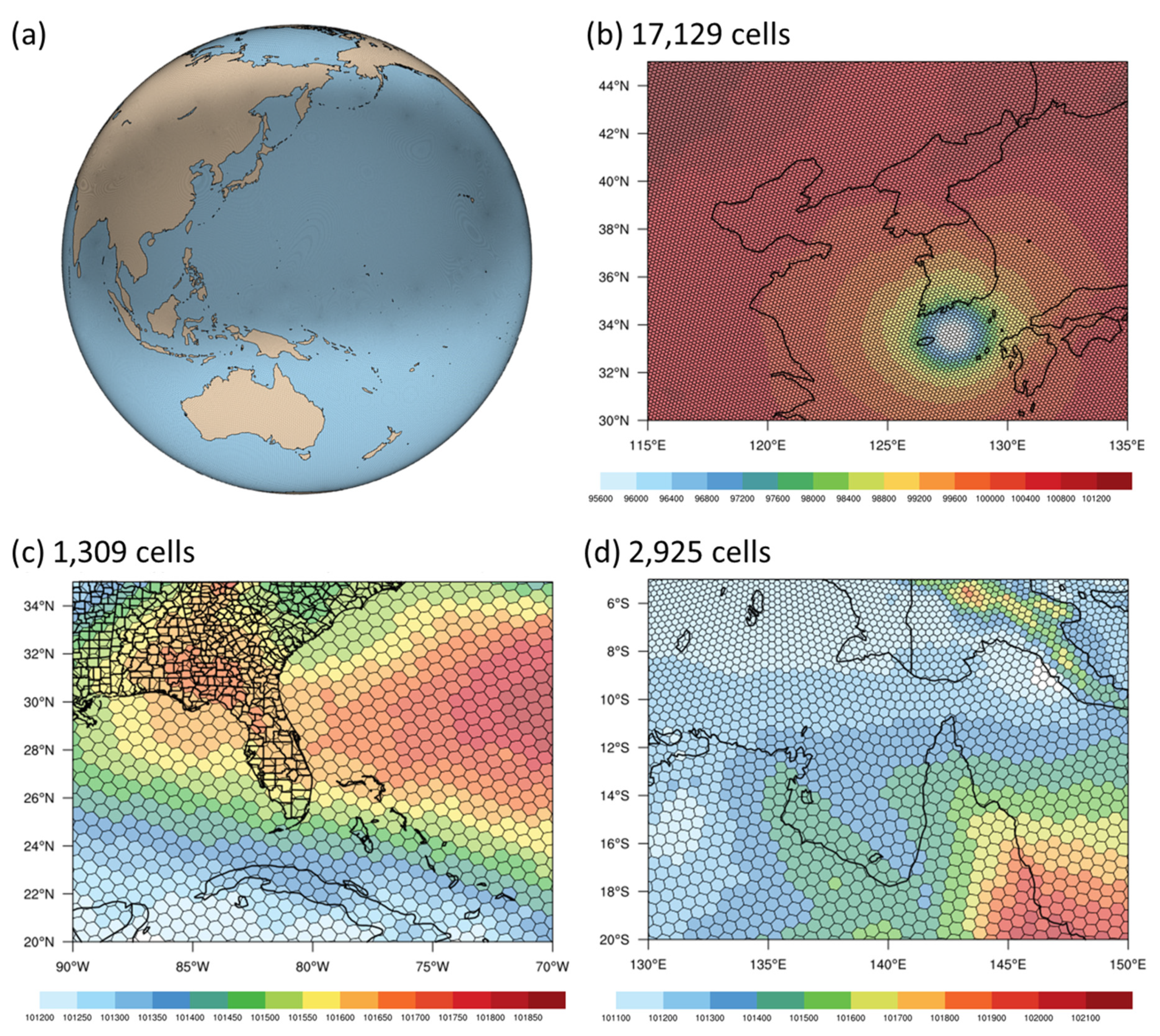
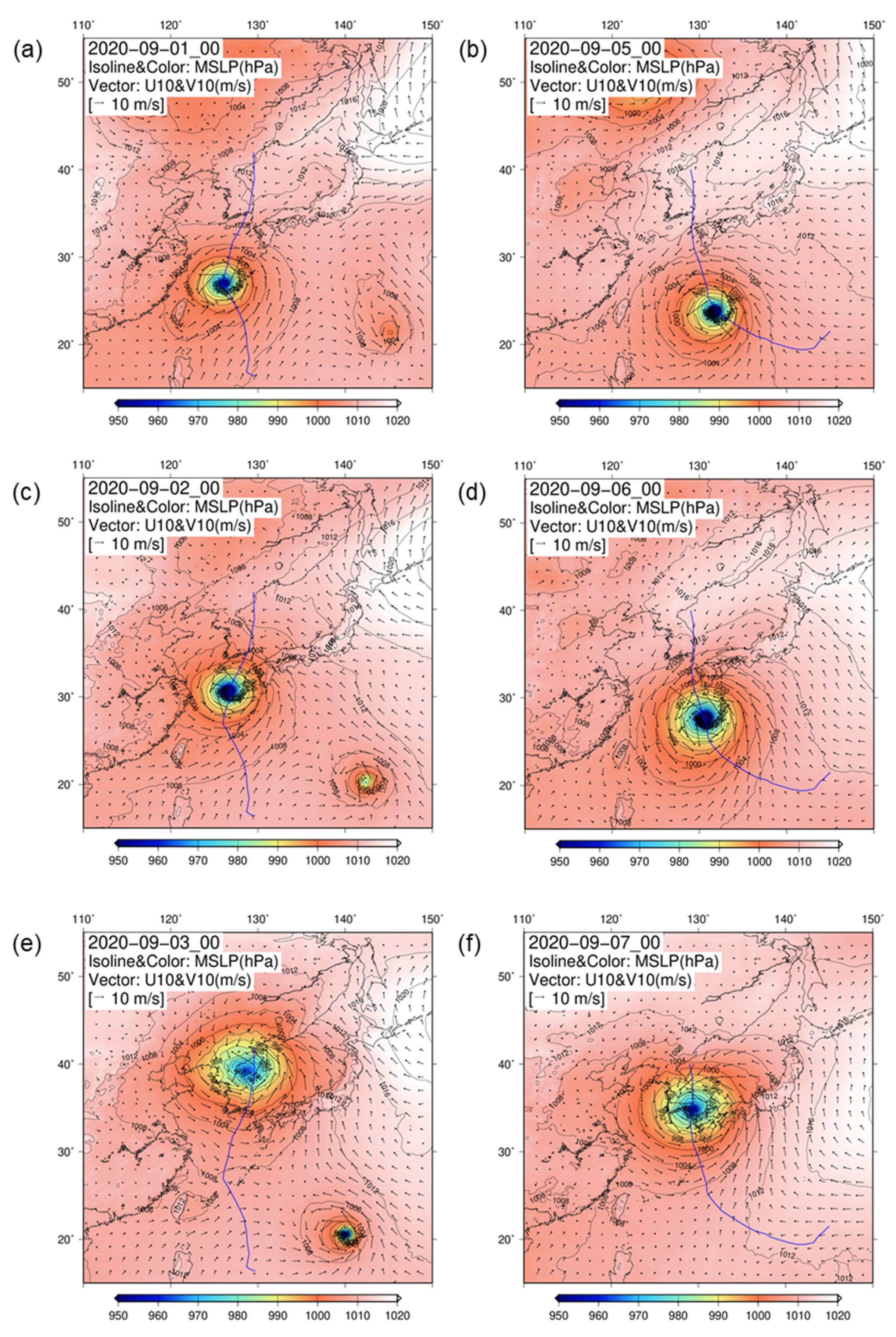
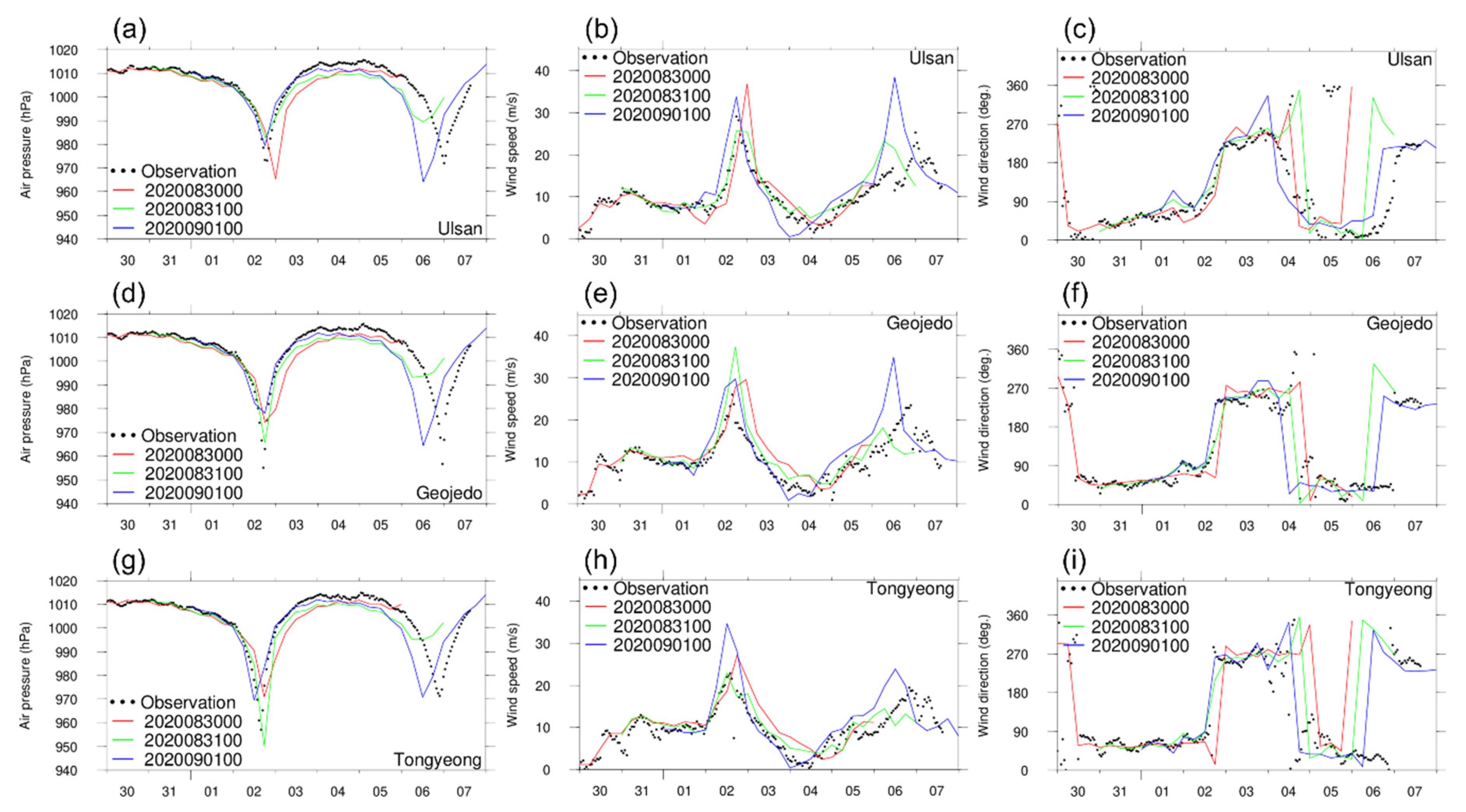
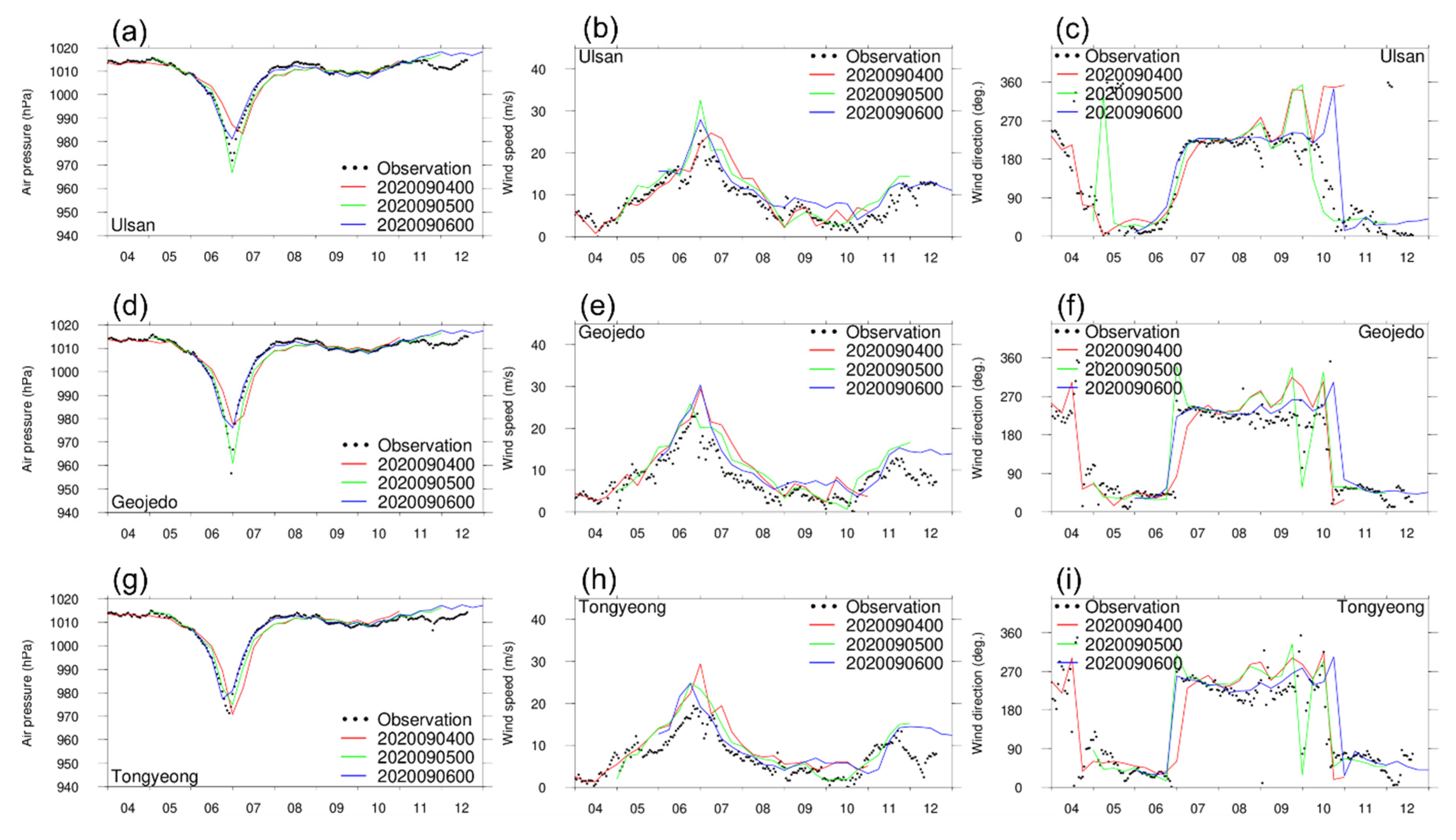
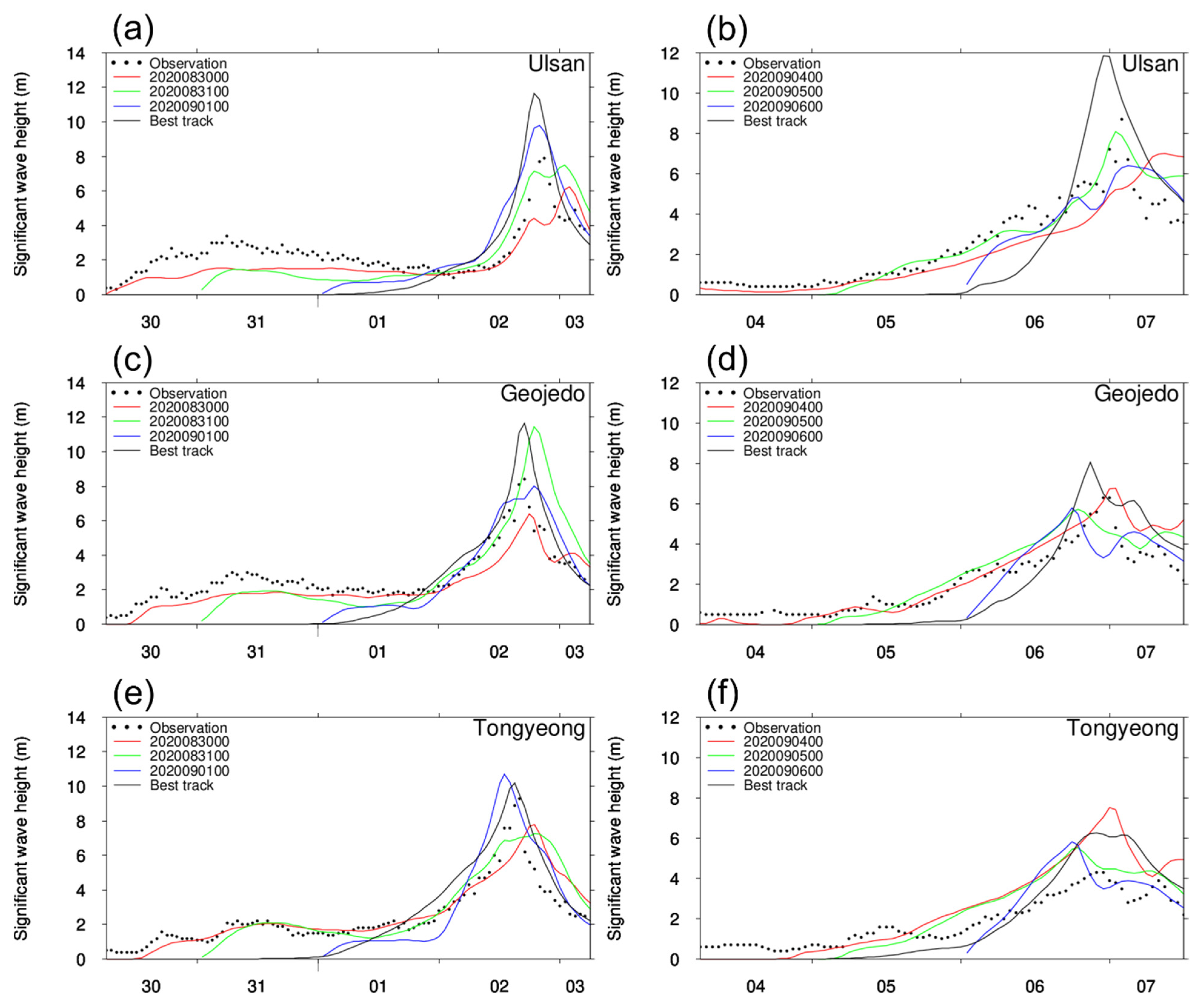

| Parameterization | Schemes | |
|---|---|---|
| Horizontal resolution | 60–15 km variable resolution | |
| No. of vertical levels | 80 | |
| Model top | 50 km | |
| Physics schemes | Microphysics | WSM6 |
| Convection | New Tiedtke | |
| Radiation (long/short waves) | RRTMG | |
| Cloud fraction for radiation | Xu-Randall | |
| Gravity wave drag by orography | YSU | |
| Boundary layer | YSU | |
| Surface layer | Monin-Obukhov | |
| Land surface | NOAH | |
| Typhoon | Hindcast (Best Track) | Forecast (MPAS) | |||
|---|---|---|---|---|---|
| Best Track Duration | Name of Sim. | Initial Time of MPAS | End Time of MPAS | Name of Sim. | |
| Bavi | 00 UTC on 21 August–12 UTC on 27 August | - | 00 UTC on 25 August | 00 UTC on 1 September | - |
| 12 UTC on 25 August | 12 UTC on 1 September | - | |||
| 00 UTC on 26 August | 00 UTC on 2 September | - | |||
| 12 UTC on 26 August | 12 UTC on 2 September | - | |||
| Maysak | 00 UTC on 26 August–12 UTC on 3 September | Best track | 00 UTC on 30 August | 00 UTC on 6 September | 2020083000 |
| 12 UTC on 30 August | 12 UTC on 6 September | - | |||
| 00 UTC on 31 August | 00 UTC on 7 September | 2020083100 | |||
| 12 UTC on 31 August | 12 UTC on 7 September | - | |||
| 00 UTC on 1 September | 00 UTC on 8 September | 2020090100 | |||
| Haishen | 06 UTC on 31 August–18 UTC on 7 September | Best track | 00 UTC on 4 September | 00 UTC on 11 September | 2020090400 |
| 12 UTC on 4 September | 12 UTC on 11 September | - | |||
| 00 UTC on 5 September | 00 UTC on 12 September | 2020090500 | |||
| 12 UTC on 5 September | 12 UTC on 12 September | - | |||
| 00 UTC on 6 September | 00 UTC on 13 September | 2020090600 | |||
| Typhoon | Wave Buoy | Forecast | Hindcast | ||
|---|---|---|---|---|---|
| 2020083000 | 2020083100 | 2020090100 | Best Track | ||
| Maysak | Ulsan | 1.068 (77) | 1.195 (53) | 1.847 (29) | 2.044 (72) |
| Geojedo | 0.885 (78) | 1.856 (54) | 1.158 (30) | 1.836 (73) | |
| Tongyeong | 0.997 (78) | 1.230 (54) | 1.728 (30) | 1.401 (73) | |
| All three | 0.986 (233) | 1.460 (161) | 1.603 (89) | 1.779 (218) | |
| Typhoon | Wave buoy | Forecast | Hindcast | ||
| 2020090400 | 2020090500 | 2020090600 | Best track | ||
| Haishen | Ulsan | 1.405 (60) | 1.078 (36) | 1.518 (12) | 2.292 (55) |
| Geojedo | 0.824 (58) | 1.022 (36) | 0.857 (12) | 1.468 (53) | |
| Tongyeong | 1.469 (60) | 1.074 (36) | 0.546 (12) | 1.356 (55) | |
| All three | 1.271 (178) | 1.058 (108) | 1.054 (36) | 1.759 (163) | |
| Typhoon | Tide Observation Station | Forecast | Hindcast | ||
|---|---|---|---|---|---|
| 2020083000 | 2020083100 | 2020090100 | Best Track | ||
| Maysak | Busan | 16.726 (78) | 17.057 (54) | 28.812 (30) | 21.386 (73) |
| Busan_New_Port | 17.854 (78) | 23.699 (54) | 25.659 (30) | 18.225 (73) | |
| Gadeokdo | 7.112 (60) | 7.316 (36) | 12.667 (12) | 14.705 (55) | |
| All three | 15.172 (216) | 18.251 (144) | 25.435 (72) | 18.599 (201) | |
| Typhoon | Tide observation station | Forecast | Hindcast | ||
| 2020090400 | 2020090500 | 2020090600 | Best track | ||
| Haishen | Busan | 14.772 (60) | 13.613 (36) | 15.977 (12) | 18.904 (55) |
| Busan_New_Port | 17.543 (60) | 14.606 (36) | 17.640 (12) | 20.848 (55) | |
| Gadeokdo | 16.860 (60) | 14.360 (36) | 16.186 (12) | 20.123 (55) | |
| All three | 16.434 (180) | 14.199 (108) | 16.617 (36) | 19.974 (165) | |
| Buoy | Ulsan | Geojedo | Tongyeong | |||
|---|---|---|---|---|---|---|
| Case | Forecast (MPAS) | Hindcast (Best Track) | Forecast (MPAS) | Hindcast (Best Track) | Forecast (MPAS) | Hindcast (Best Track) |
| Number of samples | 159 | 72 | 162 | 73 | 162 | 73 |
| Bias (m) | 0.036 | −0.687 | 0.044 | −0.568 | 0.446 | −0.059 |
| Normalized Bias | 0.353 | 0.716 | 0.255 | 0.558 | 0.233 | 0.516 |
| RMSE (m) | 1.285 | 2.044 | 1.332 | 1.836 | 1.239 | 1.401 |
| Standard Deviation (m) | 1.284 | 1.925 | 1.331 | 1.746 | 1.156 | 1.400 |
| Scatter Index | 0.777 | 1.191 | 0.723 | 0.989 | 0.636 | 0.816 |
| R2 | 0.668 | 0.613 | 0.675 | 0.830 | 0.747 | 0.872 |
| Buoy | Ulsan | Geojedo | Tongyeong | |||
|---|---|---|---|---|---|---|
| Case | Forecast (MPAS) | Hindcast (Best Track) | Forecast (MPAS) | Hindcast (Best Track) | Forecast (MPAS) | Hindcast (Best Track) |
| Number of samples | 108 | 55 | 106 | 53 | 108 | 55 |
| Bias (m) | −0.033 | −0.187 | 0.505 | −0.192 | 0.932 | 0.278 |
| Normalized Bias | 0.279 | 0.695 | 0.243 | 0.592 | 0.415 | 0.528 |
| RMSE (m) | 1.319 | 2.292 | 0.900 | 1.468 | 1.272 | 1.356 |
| Standard Deviation (m) | 1.319 | 2.285 | 0.745 | 1.456 | 0.865 | 1.327 |
| Scatter Index | 0.678 | 1.247 | 0.428 | 0.871 | 0.536 | 0.858 |
| R2 | 0.640 | 0.761 | 0.785 | 0.790 | 0.769 | 0.895 |
| Station | Busan | Busan_New_Port | Gadeokdo | |||
|---|---|---|---|---|---|---|
| Case | Forecast (MPAS) | Hindcast (Best Track) | Forecast (MPAS) | Hindcast (Best Track) | Forecast (MPAS) | Hindcast (Best Track) |
| Number of samples | 162 | 73 | 162 | 73 | 108 | 55 |
| Bias (cm) | −6.997 | −16.470 | −4.445 | −15.453 | −3.637 | −13.577 |
| Normalized Bias | 0.452 | 0.900 | 1.094 | 0.968 | 0.284 | 0.776 |
| RMSE (cm) | 19.632 | 21.386 | 21.509 | 18.225 | 7.985 | 14.705 |
| Standard Deviation (cm) | 18.343 | 13.642 | 21.044 | 9.663 | 7.109 | 5.647 |
| Scatter Index | 3.644 | 2.882 | 4.172 | 2.016 | 1.567 | 1.296 |
| R2 | 0.342 | 0.559 | 0.222 | 0.757 | 0.645 | 0.586 |
| Station | Busan | Busan_New_Port | Gadeokdo | |||
|---|---|---|---|---|---|---|
| Case | Forecast (MPAS) | Hindcast (Best Track) | Forecast (MPAS) | Hindcast (Best Track) | Forecast (MPAS) | Hindcast (Best Track) |
| Number of samples | 108 | 55 | 108 | 55 | 108 | 55 |
| Bias (cm) | 0.118 | −7.579 | 2.454 | −6.408 | 2.732 | −5.409 |
| Normalized Bias | 1.413 | 1.308 | 6.779 | 3.879 | 6.119 | 3.478 |
| RMSE (cm) | 14.538 | 18.904 | 16.633 | 20.848 | 15.993 | 20.123 |
| Standard Deviation (cm) | 14.538 | 17.318 | 16.451 | 19.839 | 15.758 | 19.382 |
| Scatter Index | 3.734 | 4.579 | 4.255 | 5.322 | 4.139 | 5.306 |
| R2 | 0.437 | 0.561 | 0.378 | 0.402 | 0.436 | 0.439 |
Publisher’s Note: MDPI stays neutral with regard to jurisdictional claims in published maps and institutional affiliations. |
© 2022 by the authors. Licensee MDPI, Basel, Switzerland. This article is an open access article distributed under the terms and conditions of the Creative Commons Attribution (CC BY) license (https://creativecommons.org/licenses/by/4.0/).
Share and Cite
Yuk, J.-H.; Kang, J.-S.; Myung, H. Applicability Study of a Global Numerical Weather Prediction Model MPAS to Storm Surges and Waves in the South Coast of Korea. Atmosphere 2022, 13, 591. https://doi.org/10.3390/atmos13040591
Yuk J-H, Kang J-S, Myung H. Applicability Study of a Global Numerical Weather Prediction Model MPAS to Storm Surges and Waves in the South Coast of Korea. Atmosphere. 2022; 13(4):591. https://doi.org/10.3390/atmos13040591
Chicago/Turabian StyleYuk, Jin-Hee, Ji-Sun Kang, and Hunjoo Myung. 2022. "Applicability Study of a Global Numerical Weather Prediction Model MPAS to Storm Surges and Waves in the South Coast of Korea" Atmosphere 13, no. 4: 591. https://doi.org/10.3390/atmos13040591
APA StyleYuk, J.-H., Kang, J.-S., & Myung, H. (2022). Applicability Study of a Global Numerical Weather Prediction Model MPAS to Storm Surges and Waves in the South Coast of Korea. Atmosphere, 13(4), 591. https://doi.org/10.3390/atmos13040591







